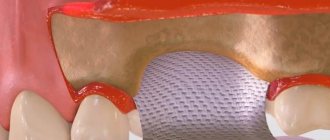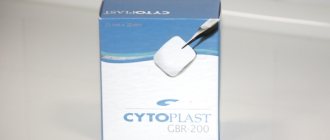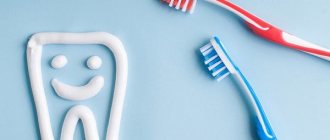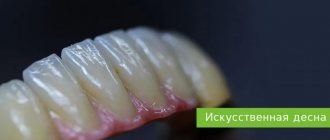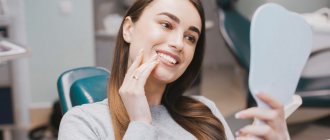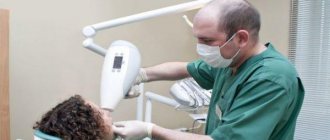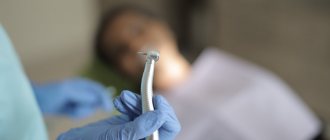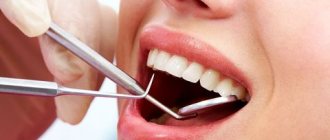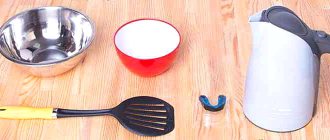Author: Brodsky Sergey Evgenievich Deputy Chief Physician, Candidate of Medical Sciences in the specialties: dentistry and medical microbiology In dentistry, almost all operations to build and restore the jaw bone contain the stage of installing membranes. Most patients who are planning to restore their eubs by installing implants and who learn more about all the stages of the operation are interested in why a membrane is used in bone grafting. Their use is required in case of acute deficiency of jaw bone tissue, if it is necessary to restore large volumes of it. The use of a membrane during implantation can successfully prevent the resorption of bone structures and eliminate bone atrophy, which creates favorable conditions for implantation of implants into it.
What is a dental membrane? Indications for installation
Dental (barrier) membranes are one of the achievements of modern dentistry, which is a thin film that is attached during the implantation procedure to the jaw, an area where bone tissue is actively destroyed. When asked frequently by patients about what bone membranes are made of, experts answer that they are most often made from collagen. The use of a collagen membrane in dentistry can effectively fix bone material, avoid further bone destruction and strengthen mobile teeth. The main indications for installing membranes are:
- a membrane is placed after tooth extraction to prevent bone tissue from shrinking;
- During bone grafting, a membrane is installed to form the missing volume of bone tissue;
- the membrane during sinus lift surgery, installed under the bottom of the maxillary sinus, reduces the risk of osteoplastic material getting into the maxillary sinus.
Types of membranes in dentistry
Today, the use of barrier membranes is the most environmentally friendly and most widely used method of strengthening deteriorating jaw bones. It is used much more often than complex bone grafting. There are several types of dental membranes:
Resorbable (resorbable). These membranes independently dissolve in the jaw tissue, so their further removal is not required. Dentists use 2 types of such membranes:
- synthetic polymers - their advantages are complete hypoallergenicity, no risk of infection transmission and long-lasting action for 5-6 months;
- xenocollagens of animal origin - have very high biocompatibility with jaw tissues.
Non-resorbable (non-absorbable). Dense dental films, which must be removed surgically, since they are not able to dissolve on their own during use. Installation of such membranes is necessary in case of significant destruction of bone tissue. There are also 2 types of them:
- frameless, used for average, up to 4 cm, lack of bone tissue;
- with a titanium frame are used for significant destruction of the jaw bones.
Membranes from the patient's blood plasma are also widely used . The plasma lifting procedure is carried out directly in the dental office and does not require special preparatory measures - the most important thing is to avoid alcohol, spicy and fatty foods on the eve of the procedure. The plasma lifting procedure itself is carried out as follows:
- Blood is taken from the patient’s vein;
- tubes with the resulting biomaterial are placed in a centrifuge for 10-40 minutes, depending on the platelet sedimentation rate of a particular patient;
- A thick clot of plasma is taken from the test tubes - it can be used in various manipulations - cut, sutured, etc.
Ready-made membranes can be stored for no more than 4 hours, so the procedure for their manufacture is carried out directly on the day of surgery.
Stages of membrane installation during implantation
Installation of dental membranes requires the surgeon not only to have operational skills, but also to have high qualifications and extensive experience. The technology of the operation consists of the following stages:
- administration of anesthesia;
- cutting and peeling of the mucous membrane;
- filling the resulting hole with granules of bone material;
- installation of a barrier membrane for bone material granules.
In rare cases (during complex operations), the installed membrane is fixed with special small pins (buttons) and the gums are sutured. If a non-resorbable membrane is sewn in, surgery is repeated after some time to remove it.
Bone membrane: application in the Partner-Med clinic
It cannot be argued that the most important step before dental implantation is the choice of a clinic and a doctor. Today, a huge number of dentists offer this service, but not all of them will provide it with high quality. Dentistry Partner-Med is one of the few Moscow clinics where the patient will undergo this procedure with the highest quality. Our highly qualified specialists, many years of experience and regularly updated levels of professional training have thousands of successfully performed operations behind them.
Our dentists know in practice when to use a membrane when installing an implant, and will immediately determine which one is suitable for a particular patient. The level of professionalism of doctors is confirmed by numerous reviews from patients who are no longer ashamed of their smile.
Our additional advantages are:
- free initial consultation;
- individual selection of treatment;
- reasonable prices for services;
- permanent promotions.
Deputy Chief physician Sergey Evgenievich Brodsky
Sign up for a free consultation
+7
Just CALL US!
+7
We will answer any of your questions and will definitely help you!
In what cases are barrier and protective membranes applied?
Membrane linings perform several functions:
- Protective - protect the operated area from external factors.
- The role of the reinforcing material is to fix the osteoplastic material in a suitable position.
Applicable:
- when strengthening mobile units;
- to protect bone from atrophy after tooth extraction;
- when it is necessary to fix granules of osteoplastic material during osteoplasty before or during implantation;
- when building up the jaw bone with blocks.
The decision to use barrier membranes is made by the dentist after a preliminary examination.
To increase bone
An osteoplastic material is fixed under the gum, on top of which a protective pad is placed. It protects the bed and its contents from growing soft tissues. Eliminates washing out of the bone graft from the wound through the suture line. More reliable treatment results are provided by the use of a bone substitute along with two types of membranes. One of them covers the defect and osteoplastic material, and a collagen plate is placed on top of it.
Gum extension (augmentation) during gum recession
Deficiency of soft tissues as a result of atrophy is characteristic of patients with long-term absence of teeth. Significant bone loss in such cases is accompanied by a proportional decrease in gum volume, which causes significant discomfort. Augmentation is more expensive and more difficult to install an implant. Gum augmentation can be performed with non-resorbable membranes, usually based on a non-porous material and resorbable, with a high rate of tissue compatibility. The method promotes rapid healing, reduces the risk of relapse and soft tissue swelling.
Contraindications
Contraindications for which the use of the product is strictly unacceptable are:
- infectious processes in the oral cavity in the acute stage of progression , as well as any manifestations of an inflammatory nature in the area of implantation - both acute and chronic course of the disease;
- general diagnoses , when maxillofacial surgery is not performed for objective reasons, as well as in the presence of contraindications to periodontics, surgical dentistry, endodontology and prosthetics by implantation;
- individual intolerance to elements of pork collagen , which can cause an acute allergic reaction.
Types of biomaterials used
The method of directed tissue regeneration in surgical dentistry is based on the use of two main groups of membranes: resorbable (collagen, vicryl, polylactic acid, etc.) and non-resorbable (Gore-tex or titanium mesh, with titanium reinforcement, Teflon and others).
Resorbable
Installation of absorbable membranes prevents their removal after the osteoplastic material has engrafted. Such linings do not always remain stable over a long period. To enhance the prolonged action, their composition is supplemented with slowly resorbing substances. One of the main advantages of membrane linings is the possibility of enriching their structure with drugs that enhance osteogenesis, anti-inflammatory, antimicrobial agents, etc.
Types of resorbable membranes:
- Synthetic polymers (polyactides, polyglycolides) and their chemical modifications (for example, Guidor, EpiGuide, Vicryl) - decomposition into microscopic fragments that undergo phagocytosis occurs under the influence of hydrolysis. Among the disadvantages of the products, weak tissue integration and a high likelihood of developing swelling during resorption due to changes in pH in the tissues are noted. Advantages of polymer plates:
- no risk of transmitting an infectious disease;
- hypoallergenic;
- long-term effect (5-6 months).
Non-resorbable
They contribute to the effective restoration of bone in a given volume and trajectory, there are:
- Frameless - for restoration of bone tissue less than 4 mm.
- With a titanium frame - for bone restoration in large volumes, in all directions.
Main advantages:
- high mechanical strength;
- pronounced barrier properties.
These types of pads should be removed after 6-9 months . Consisting of titanium, they are effective in situations where there is a large load on the bone and it is necessary to protect implants or osteoplastic material. The most common indication for use is vertical ridge augmentation. They are removed after restoration of soft and bone tissues damaged during the operation.
Main disadvantages:
- risk of exposure - during suturing of the flap, the insert must be completely closed;
- absence of the process of periosteum formation under the overlay;
- the patient needs to visit the dentist frequently (every 2 weeks).
Statistics show that the most effective membranes are polytetrafluoroethylene (PTFE) GoreTex and aliphatic polyetherurethane (Bone-up). Less commonly used are mesh forms made of calcium sulfate (Capset) or titanium (Frios, BoneShield, Tiomesh).
Origin story
The first membranes are practically not similar in composition and nature of origin to modern products. In their manufacture, bovine fragments of pericardial and Achilles tendon tissue were used.
Nowadays, pig cells are used in the production process. This option is more preferable because it completely eliminates the possibility of BSE infection.
In addition, the substance of pork collagen of the nature of formation is more adapted to the composition of human cells, which ensures their complete biocompatibility.
Porcine dermis, certain areas of the peritoneum, and pericardium are taken as the initial raw product. The performance characteristics of these zones - the ability of cells to split, and improved barrier function - meet all the requirements for the material.
Fixing elements of different types
The membrane is adjusted to the size of the defect, or the required dimensions are transferred to it using sterile templates in the package. The edges should overlap the boundaries of the bone defect by at least 2-3 mm . Fixation can occur in one of several ways:
- Before installation, the resorbable pad is pierced and placed on the implant using the rubber dam principle. The edges are secured with screws or pins into the bone, in which holes are previously created with burs. Additionally secured with sutures to the periosteum. When used on the upper jaw, titanium pins with a wide head are used for fastening.
- The self-curing mixture or film with an adhesive composition is fixed directly to the alveolar process.
- Non-resorbable plates are fixed with titanium pins or microscrews. The edges of the barrier must be tightly adjacent to the bone to prevent soft tissue ingrowth. When suturing the mucosa, small diameter suture material is used. The thread should pass along the edge of the membrane in contact with the neck of the implant. The stitching is done in the middle of the overlay between the edge stitches.
Opinion of a dentist-implantologist : “The success of implantation depends on how accurately patients follow medical recommendations. The operated area should be protected from hard, hot foods. Hygiene must be regular. Medications are taken only in consultation with a doctor.”
- Complete restoration of the dentition in just 4 days!
more detailsRoott Pterygoid Implants Sinus lift is no longer needed!
more details
Once and for life! Express implantation in 4 days with a permanent ReSmile prosthesis
more details
All-on-4, All-on-6, ReSmile, Zygomatic implantation We use all modern methods of dentition restoration
more details
Benefits of Collagen Membrane, Genoss
- the minimum period of epithelization in the open state is only 2-3 weeks (!),
- size (thickness 0.3 mm),
- resorbability in 8-10 months,
- rigidity is a guarantee of excellent barrier function and reliable stabilization of bone material,
- ease of use.
The excellent characteristics of the Genoss membrane have already been appreciated by many dentists, so today you can inexpensively buy a Genoss collagen membrane in the Dental Market online store.
The price of the Genoss collagen membrane at Dental Market is more than acceptable, especially considering the real opportunity to receive free consultation from a specialist, assistance in placing an order and fast delivery.
Call Dental Market by phone 8 (495) 118-76-20
.
Online store "Dental Market" - flexible prices, quick help in any situation!
How membranes take root during dental implantation
Collagen membrane overlays reduce the risk of complications due to loss of soft tissue. Non-stitched - due to the healing of soft tissues by secondary intention, the wounds are protected from the general inflammatory process. Both types integrate well into the jaw tissue. The bone under the surface of the barrier plate is regenerated in a manner similar to fetal bone growth.
When using absorbable overlays, the postoperative wound heals without the use of additional medications. Often the healing process of non-resorbable membranes is accompanied by complications, in particular, exposure of the structure. This can lead to infection and inflammation, which means it will have to be removed prematurely.
Often, under the barriers a favorable background is created for the development of microbes, so it is not always possible to achieve the desired result.
What is platelet fibrin
Platelets
- flat, colorless blood cells that participate in clotting and help stop bleeding. When the integrity of a blood vessel is disrupted, platelets are destroyed and substances are released that form a blood clot or thrombus. In the 1980s, an additional property was discovered: the ability to accelerate the regeneration of damaged tissue. This occurs due to the release of peptide and steroid hormones (growth factors) that stimulate the restoration of old cells and the growth and division of new cells.
Plasma
- not just platelets, but enriched platelet fibrin. This is a pale yellow liquid formed after blood is centrifuged. It contains platelets and other biologically active substances:
- proteins (fibrin, formed from fibrinogen);
- lipids;
- hormones and hormone-like substances;
- amino acid metabolites;
- vitamins;
- minerals.
After the injection of autoplasma into the jaw bone, growth factors are activated and gradually released within 7 days. They improve the supply of oxygen to tissues due to the formation of a dense capillary network (neovascularization). Favorable conditions are created to normalize trophism, accelerate regeneration and activate cellular growth in the jaw bone.
Human plasma contains useful substances and is bioinert to tissues, because is a product of the same organism. For this reason, there is never any rejection or side effects from platelet concentrate injections. Injection of autoplasma provides a predictable course of the postoperative period.
Membrane exposure after bone grafting - consequences and treatment
The non-resorbable membrane pad is exposed in 1% of cases , causing the following consequences:
- wound infection with the development of purulent inflammation;
- rejection of osteoplastic material during vascularization of the mucous membrane (in 40-50% of cases).
In such situations, it is recommended to remove the implanted materials, carry out treatment, and then repeat bone grafting. Typically, a second layer of soft tissue is formed under the incision using a mucoperiosteal flap. To do this, it is peeled off, split, modeled, and then sutured in layers.
The exposed resorbable pad should be treated with 3% hydrogen peroxide and 0.12% chlorhexidine. Sometimes this allows you to postpone the removal procedure by 8 weeks.
Opinion of a dental surgeon : “Most of my patients are smokers. Many people do not immediately realize the complexity of the situation caused by their bad habit. Smoking causes a sharp narrowing of the blood vessels in the mouth. This weakens the flow of blood filled with oxygen and nutrients. Due to their lack, the healing process is delayed. Therefore, you need to completely stop smoking at least a couple of weeks before implantation and for several months after it.”
Indications
The main indication for use of the product is delayed or instantaneous tissue regeneration based on the directed principle of action, which is manifested in the following clinical diagnoses:
- defects in the walls of bone fragments - this pathology, as a rule, is a consequence of incorrect surgical intervention;
- to support the normal state of the nasal mucous membranes - against the background of augmentation of the sinus node base;
- for jaw augmentation in the ridge area - the technique is especially effective when carrying out manipulations aimed at restoring the jaw ridge and ensuring the possibility of subsequent tooth restoration through prosthetics;
- against the background of identifying denestration pathologies - regardless of the degree of their progression;
- to eliminate defects in periodontal fragments;
- atypical manifestations of dehiscence;
- after amputation of the apical root region , elimination of cystic formations, removal of temporary teeth that did not fall out on their own in due time;
- bone resections – varying degrees of damage;
- after dental amputation - for post-extraction of the alveolar;
- with augmentation – both instant and delayed.
Popular manufacturers
Manufacturers of collagen membranes are world famous brands. These are companies with a developed research base and scientific developments.
The quality of the product meets all stated requirements and does not pose a risk to the patient’s health. It is advisable to review the most popular plate manufacturers.
Collprotect membrane
It has a rough three-dimensional porous surface. Allows you to guarantee controlled healing and achieve lasting positive dynamics.
During regenerative processes, the material prevents the development of inflammation.
The peculiarities of the biological structuring of the product do not allow soft tissues to grow beyond the norm, and the product itself, in fulfilling its purpose, quickly integrates into the natural cells of the body.
Distinctive properties:
- three-dimensional matrix content;
- control of the healing function and stop bleeding;
- the optimal resorption period is up to 12 weeks;
- ability to interact with dry and wet environments;
- natural porous structure.
Indications:
- sinus lift;
- well preservation;
- deep intraosseous pathologies;
- closing perforations.
Jason membrane
Has a patented production technology. Distinctive properties:
- ease of use;
- natural mechanical and biological effects;
- exact result.
It is installed according to the principle of a multi-vector network, due to which the barrier function lasts an order of magnitude longer - about six months.
It is characterized by low thickness, strength and elasticity of the coating. Does not stick together after rehydration. Excellent tensile strength.
Application area:
- implantation;
- closing fenestrations;
- alveolar restoration;
- intraosseous pathologies;
- stopping the processes of bone atrophy.
Alpha-Bio's GRAFT Collagen Membrane
The model is indicated for use in cases involving the regeneration of hard and soft tissue fragments by delayed or immediate directed regeneration:
- surgical defects;
- sinus lift;
- ridge augmentation;
- periodontal anomalies;
- dehiscence.
It has a somewhat wavy structure, two layers. It is laid on the work surface with the smooth side, while the edge defect must be covered by 2 mm. Prevents lateral junctional invasion.
Application for tissue regeneration
To restore soft tissues, the product is used without pre-treatment, straight from the package.
The doctor evaluates the area of the defect and trims the flap of the product to the appropriate size. The material is applied to the defect area and spontaneously adheres to the tissue. If necessary, stitches are applied.
The material can be used as a soft tissue replacement if it is not possible to install an autogenous graft (for example, if there are increased risks associated with taking soft tissue from the patient).
The product in this case provides the structure of the guide splint, increasing the volume and promoting the ingrowth of soft tissue.
Tissue cells occupy space in the porous structure of the product, and with its absorption they fill all the necessary space.
Use for bone restoration
Being a highly purified natural component, membranes made from this material are successfully used in bone restoration.
Having a three-dimensional matrix structure and excellent biocompatibility, its natural composition helps to efficiently restore hard bone fragments.
The product has two sides - smooth and rough. A smooth surface intensively heals wounds, and a rough surface activates cellular bone growth.
Can be used either independently or in combination with patient cellular material.
The main advantage of use is improved bone formation and minimal trauma to the working area . In addition, it is an obstacle to the growth of surrounding soft fragments, in which these processes occur much faster.
The video shows the process of using a collagen membrane in bone grafting.
Flaws
Collagen of pork origin is not without its drawbacks. These include:
- allergic intolerance - this phenomenon is quite rare, as a rule, the material is well tolerated by the patient’s body;
- in isolated situations there is a risk of inflammation of the tissues surrounding the product, caused by longer resorption of the component;
Since this element, although it is maximally adapted in composition to human cells, is still a foreign body, and, therefore, there is always a risk of transition of existing infectious manifestations to the acute stage.
